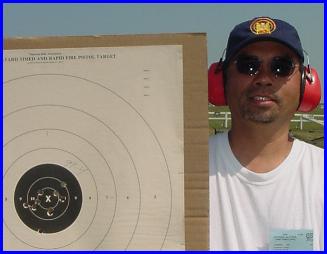
Greetings Shooters,
The apparent target image size through the red dot scope has perplexed many of us. Is it smaller, larger, or the same size through the scope? I would like to eliminate any mysteries and allow each of us to accurately evaluate what we see through our red dot scopes.
We need to heighten our awareness and be critical in order to judge target size properly. Look through your scopes and view a bullseye, either at 50 or 25 yards. As you fixate upon the bull, wave the scope left and right, again and again. A true 1x scope would allow no "movement" of the bull as you wave the scope.
A scope which minifies the target would allow a slight "movement" of the bull towards the direction of the scope motion. Unlike a 1x scope, this bull will move to the right as you wave the scope to the right, and conversely, the bull will move to the left as you wave the scope to the left. This bull movement is very, very slight, but it should readily be detected. As you continuously wave the scope, the bull will appear to wiggle.
As I have mentioned a number of times, I have a red dot scope which magnifies the target image. As I wave this scope to the right, the bull will have a slight movement to the left, just the opposite of the previous situation. The bull wiggles will be in the opposite direction as I wave this scope.
Those of you who are not sure what you are looking for may first use your eyeglasses instead of the red dot scope. The motion will be easier to see. Nearsighted prescription lenses will cause images to look smaller, and these images will move in the same direction as the motion of the lens. Farsighted prescription lenses will have the opposite effects, a larger image with opposite image motion.
As I evaluated the movement of the bull with actual diopter lenses, I was able to approximate this bull movement by holding small power lenses and waving them left and right. I estimated that it would take less than 0.12 diopter to duplicate equivalent movement of the bull of two of my scopes. One scope made the bull smaller, one scope made the bull larger. Two other scopes did not change the apparent bull size at all.
If you would recall my article entitled, "Inaccuracies with Eyeglass Prescriptions," there is an acceptable tolerance of + or - 0.12 diopter to our eyeglass prescriptions by the optical industry. My two scopes which have exhibited bull movement would certainly fall within this range.
As a concluding and important note, does the minification or magnification affect our shooting? Not a bit! In fact, for over two years, I've shot with the scope which made the target smaller, and I never even noticed it until I evaluated my scope for this article. I went from a sharpshooter to a master classification and this scope was never the reason for a poor string. We are fortunate that companies such as Ultradot offer such a great warranty, and as I have written before, we need to put everything into perspective. The many minutiae involved with shooting are not problems unless we make them so. As such, we loose focus as to what is really important.
As an interesting side note, those of us who are nearsighted will happen to see "everything" smaller than normal as we use our eyeglasses, regardless of the scope. The higher the nearsightedness, the smaller the images of everything we see. Of course, the opposite would also be true. The higher the farsightedness, the larger the images. The following would give us the proportional image size differences.
| Power: | Approximate Change In Image Size: |
A +5.00 hyperope would then see the target 20% bigger than a -6.00 myope. That would extrapolate to about an apparent 1 3/4" larger bull at 50 yards,....and those of you who are farsighted thought you were handicapped with your poor vision. Wasn't this fun!
Good Vision and Good Shooting To All,
Norman H. Wong, O.D.
